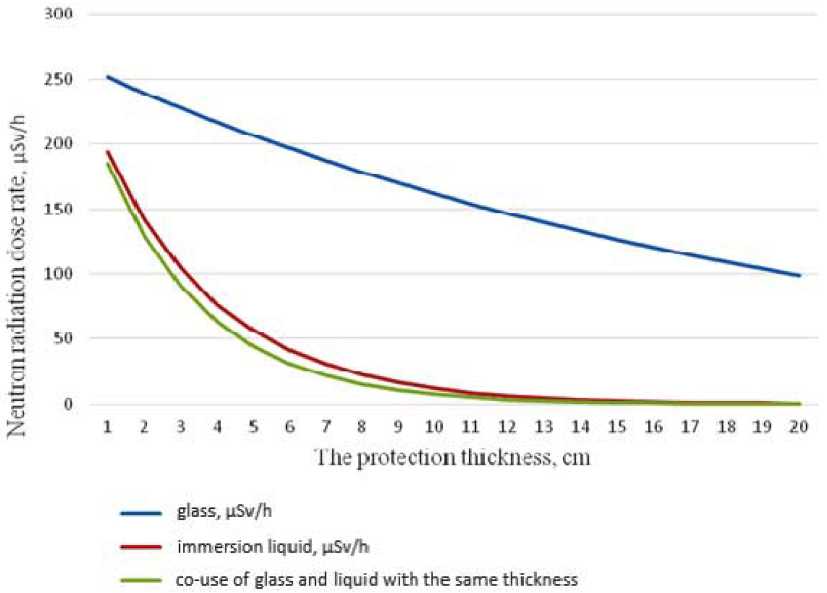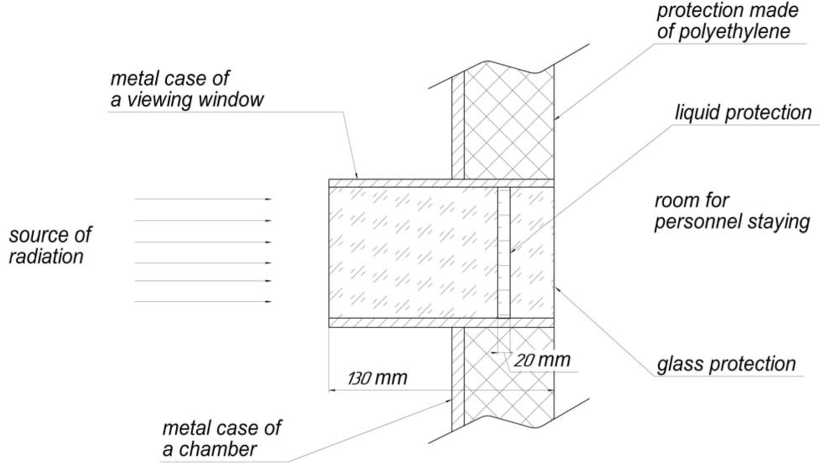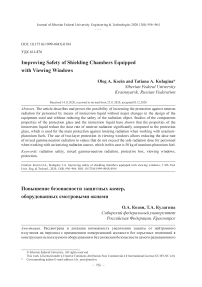Improving safety of shielding chambers equipped with viewing windows
Автор: Kozin Oleg A., Kulagina Tatiana A.
Журнал: Журнал Сибирского федерального университета. Серия: Техника и технологии @technologies-sfu
Статья в выпуске: 8 т.13, 2020 года.
Бесплатный доступ
The article describes and proves the possibility of increasing the protection against neutron radiation for personnel by means of immersion liquid without major changes in the design of the equipment used and without reducing the safety of the radiation object. Studies of the components properties of the protection glass and the immersion liquid have shown that the properties of the immersion liquid reduce the dose rate of neutron radiation significantly compared to the protection glass, which is used for the main protection against ionizing radiation when working with uranium- plutonium fuels. The use of two-layer protection in viewing windows allows reducing the dose rate of mixed gamma-neutron radiation to values that do not exceed the safe radiation dose for personnel when working with an ionizing radiation source, which in this case is 50 kg of uranium-plutonium fuel.
Radiation safety, mixed gamma-neutron radiation, protective box, viewing windows, protection
Короткий адрес: https://sciup.org/146281623
IDR: 146281623 | УДК: 614.876 | DOI: 10.17516/1999-494X-0194
Текст научной статьи Improving safety of shielding chambers equipped with viewing windows
Цитирование: Козин, О.А. Повышение безопасности защитных камер, оборудованных смотровыми окнами / О.А. Козин, Т.А. Кулагина // Журн. Сиб. федер. ун-та. Техника и технологии, 2020. 13(8). С. 956–964. DOI: 10.17516/1999-494X-0194
protection of personnel, it is necessary to reduce the amount of fissile materials in the boxes, which affects technological processes negatively [12, 13, 18, 19].
Thus, the purpose of this work is to ensure reliable protection of personnel when performing a production task with maximum productivity with a given amount of fissile material.
Calculation of the total dose rate of gamma-neutron radiation
At mining and chemical combine (Zheleznogorsk), when producing mixed uranium-plutonium fuel, the process box can contain up to 50 kg of the mixture at the same time in the form of fuel pellets, which content consists of plutonium in the form of PuO2 (the quantity is equal to 20 %), the rest is uranium. Isotopic composition of plutonium (mass, %): 238Pu – 2,94; 239Pu – 57,0; 240Pu – 23,05; 241Pu – 10,77; 242Pu – 6,24; isotopic composition of uranium (mass, %): 235U – 0,925; 238U – 98,4; 236U – 0,623; 234U – 0,002 [20].
When evaluating radiation factors [12, 13], calculations showed that the dose rate of mixed gamma-neutron radiation at a distance of 0.5 meters, taking into account the design of the box, has an unacceptably high value, exceeding the standard value (12 μSv/h) by 250 times. Neutron radiation was calculated using the formula (1) [13]
o= , (1)
where Q is the flux density, n/сm2·s; Q 0 is the partial neutron flux, n/s; F = е -ln(2) t / T= e -0,693 t/T – coefficient taking into account the change in the total flux density of neutrons due to the decay of a radioactive isotope; and R is the distance from the effective surface of the source, cm.
The conversion of the neutron flux density to the EDR (exposure dose rate) of neutron radiation was performed using the average conversion coefficient calculated from the effective dose per unit fluence under the condition of irradiation with a parallel neutron beam in the anterior-posterior geometry for the neutron energy range from 0.1 to 8 MeV [13, 15]. The results of calculations of the
Table 1. Calculation of exposure dose rate of neutron radiation from plutonium at 0.5 m from the radiation source
|
Nuclide |
Isotope content, % |
Specific activity, Bq/g |
Intensity, Bq |
Neutron radiation, n/s·g(nuc) |
Neutron radiation, n/s |
Flux density, n/s·сm2 |
EDR, μSv/h |
||
|
(α, n ) |
spontaneous |
total |
PuO 2 |
PuO 2 |
PuO 2 |
||||
|
238 Pu |
2,94 |
6,34E+11 |
1,64E+14 |
1,38E+04 |
2,50E+03 |
1,63E+04 |
4,22E+06 |
1,13E+02 |
1,40E+02 |
|
239 Pu |
57 |
2,30E+09 |
1,15E+13 |
3,30E+01 |
2,20E-02 |
3,30E+01 |
1,66E+05 |
5,27E+00 |
6,53E+00 |
|
240 Pu |
23,05 |
8,44E+09 |
1,71E+13 |
1,26E+02 |
9,00E+02 |
1,03E+03 |
2,08E+06 |
6,61E+01 |
8,20E+01 |
|
241 Pu |
10,77 |
3,81E+12 |
3,61E+15 |
1,00E+00 |
2,90E-02 |
1,03E+00 |
9,75E+02 |
1,08E-02 |
1,34E-02 |
|
242 Pu |
6,24 |
1,46E+08 |
8,02E+10 |
1,60E+00 |
1,57E+03 |
1,57E+03 |
8,63E+05 |
2,75E+01 |
3,41E+01 |
|
Total |
100 |
– |
3,80E+15 |
– |
– |
2,22E+05 |
7,33E+06 |
2,12E+02 |
2,63E+02 |
Note: The obtained value of exposure dose rate of neutron radiation from plutonium is equal to 2,63 ∙ 102 µSv/h.
neutron radiation EDR are shown in Tables 1 and 3, and the gamma radiation EDR are presented in Tables 2 and 4 [12–15].
Table 2. Calculation of exposure dose rate of gamma radiation from plutonium at 0.5 m from the radiation source
|
Nuclide |
Isotope content, % |
Specific activity, Bq/g |
Intensity, Bq |
Specific dose rate of gamma radiation, µSv/h g-1 h-1 |
EDR, μSv/h |
|
PuO 2 |
PuO 2 |
||||
|
238 Pu |
2,94 |
6,34E+11 |
1,64E+14 |
1,81E+00 |
1,87E+03 |
|
239 Pu |
57 |
2,30E+09 |
1,15E+13 |
1,52E-02 |
3,05E+02 |
|
240 Pu |
23,05 |
8,44E+09 |
1,71E+13 |
2,60E-02 |
2,11E+02 |
|
241 Pu |
10,77 |
3,81E+12 |
3,61E+15 |
1,70E-01 |
6,44E+02 |
|
242 Pu |
6,24 |
1,46E+08 |
8,02E+10 |
8,05E-04 |
1,77E+00 |
|
Total |
100 |
– |
3,80E+15 |
- |
3,04E+03 |
Note: The obtained value of exposure dose rate of gamma radiation from plutonium is equal to 3,04 ∙ 103 µSv/h.
Table 3. Calculation of exposure dose rate of neutron radiation from uranium at 0.5 m from the radiation source
|
Nuclide |
Isotope content, % |
Specific activity, Bq/g |
Intensity, Bq |
Neutron radiation , n/s·g (nuc) |
Neutron radiation, n/s |
Flux density, n/s·сm2 |
EDR, μSv/h |
||
|
(α, n ) |
spontaneous |
total |
UO 2 |
UO 2 |
UO 2 |
||||
|
234 U |
0,002 |
2,32E+08 |
1,63E+08 |
3,00E+00 |
5,02E-03 |
3,01E+00 |
2,12E+02 |
6,73E-03 |
8,35E-03 |
|
235 U |
0,925 |
8,01E+04 |
2,61E+07 |
7,10E-04 |
2,99E-04 |
1,01E-03 |
3,29E+01 |
1,05E-03 |
1,30E-03 |
|
236 U |
0,623 |
2,39E+06 |
5,24E+08 |
2,40E-02 |
5,49E-03 |
2,95E-02 |
6,47E+02 |
2,06E-02 |
2,55E-02 |
|
238 U |
98,45 |
8,44E+09 |
2,92E+14 |
8.30E-05 |
1,36E-02 |
1,36E-02 |
4,71E+04 |
1,50E+00 |
1,86E+00 |
|
Total |
100 |
– |
2,92E+14 |
– |
– |
3,05E+00 |
4,80E+04 |
1,53E+00 |
1,90E+00 |
Note: The obtained value of exposure dose rate of neutron radiation from uranium is equal to 1.9 µSv/h.
Table 4. Calculation of exposure dose rate of gamma radiation from uranium at 0.5 m from the radiation source
|
Nuclide |
Isotope content, % |
Specific activity , Bq/g |
Intensity, Bq |
Coefficient of effective dose rate of external photon irradiation, µSv/h Bq-1 h-1 |
EDR, μSv/h |
|
UO 2 |
UO 2 |
||||
|
234 U |
0,002 |
2,32E+08 |
1,63E+08 |
1,70E-10 |
1,11E-01 |
|
235 U |
0,925 |
8,01E+04 |
2,61E+07 |
1,61E-08 |
1,68E+00 |
|
236 U |
0,623 |
2,39E+06 |
5,24E+08 |
1,51E-10 |
3,17E-01 |
|
238 U |
98,45 |
1,24E+04 |
4,30E+08 |
1,33E-10 |
2,29E-01 |
|
Total |
100 |
– |
1,14E+09 |
- |
2,34E+00 |
Note: The obtained value of exposure dose rate of gamma radiation from uranium is equal to 2.34 µSv/h.
The total dose rate of gamma-neutron radiation from 50 kg of the mixture located in the process box at a distance of 0.5 meters from the radiation source corresponds to 3,3 ∙ 103 µSv/h. To ensure the safe operation of shift personnel, the dose rate of mixed gamma-neutron radiation should be reduced by 250 times [15, 16].
The design of the protective screens
To design protection screens, it is necessary to study the protection properties of the materials used (protection glass and immersion liquid) against neutron radiation. As a protection glass, it is convenient to use lead-free glass that effectively protects against gamma radiation of the following composition:
ВаО – 40–42 %, Nb 2 O 5 – 0,3–0,9 %, CeO 2 – 0,4–0,8 %, Sb 2 O 3 – 0,4–1,5 %, P 2 O 5 – 55–57 %.
The attenuation of neutron radiation by glass components is calculated using the following formula (2) [13]:
J=Jve^x (2)
where J is the neutron ERD after the screen, µSv/h; J 1 is the neutron ERD before the screen, µSv/h; e is the base of the natural logarithm –2.718; Σ is the macroscopic cross-section of interaction with matter, см-1; x is the screen thickness, cm.
The macroscopic cross section of the interaction of neutrons with matter is calculated by the formula (3) [13]:
p • Мд
2 = -^—-(^1- ^1+^2" ^2-) (3)
where ρ is the density of the substance, g/cm3; NА is the Avogadro number (6.022 ∙ 1023), mol-1; M is the mass, g/mol; σ is the microscopic cross-section of the element, cm2; n is the number of nuclei of the element.
Each compound is calculated separately for multicomponent substances. Then, the results are summarized, taking into account the mass content of components in the substance [13]. Evaluation of macroscopic cross-section of protective glass interaction:
-
1. ВаО – 40–42 %, Ba – 89,5 %, O – 10,5 %, m = 153,32 g/mol, ρ = 5,7 g/сm3, Σ 1 = 0,042 cm-1;
-
2. Nb 2 O 5 – 0,3–0,9 %, Nb – 69,9 %, O – 30,1 %, m = 265,8 g/mol, ρ = 4,5 g/сm3, Σ 2 = 0,033 сm-1;
-
3. CeO2 – 0,4–0,8 %, Ce – 81,4 %, O – 18,6 %, m = 172,11 g/mol, ρ = 6,4 g/сm3, Σ3 = 0,055 сm-1;
-
4. Sb 2 O 3 – 0,4–1,5 %, Sb – 83,5 %, О – 16,5 %, m = 291,5 g/mol, ρ = 5,6 g/сm3, Σ 4 = 0,127 сm-1;
-
5. P 2 O 5 – 55–57 %, P – 56,4 %, O – 43,6 %, m = 141,9 g/mol, ρ = 2,4 g/сm3, Σ 5 = 0,054 сm-1.
-
6. Cd(NO 3 ) 2 – 30 %, Cd – 47 %, N – 13 %, O – 40 %, m = 236,42 g/mol, ρ = 3,6 g/сm3, Σ 6 = 0,061 сm-1;
-
7. Pb(NO 3 ) 2 – 20 %, Pb – 62,5 %, N – 8,5 %, O – 30,0 %, m = 331,5 g/mol, ρ = 4,53 g/сm3, Σ7 = 0,052 сm-1;
-
8. Н 2 O – 50 %, H – 11,2 %, O – 88,8 %, m = 18 g/mol, ρ = 1,0 g/сm3, Σ 8 = 0,560 сm-1.
The total macroscopic cross-section of the interaction of neutrons with energy of 1MeV of the protective glass, in accordance with the specific mass fraction of the compound in the substance, will be:
Σ ст = Σ 1 ∙ 0,42 + Σ 2 ∙ 0,009 + Σ 3 ∙ 0,008 + Σ 4 ∙ 0,015 + Σ 5 ∙ 0,57 = 0,049 cm-1.
Evaluation of neutron protection by an immersion liquid with good protection properties against both neutron and gamma radiation of the following composition [13]:
The total macroscopic cross-section of the interaction of neutrons with energy of 1MeV of the immersion liquid, in accordance with the fraction of components, will be:
Σ ж = Σ 6 ∙ 0,30 + Σ 7 ∙ 0,20 + Σ 8 ∙ 0,50 = 0,309 сm-1.
Calculations have shown that the macroscopic cross-section of the interaction of neutrons in the immersion liquid is 6.3 times higher than that of the protection glass, so it became possible to produce an optimal two-component protection to protect personnel from mixed gamma-neutron radiation [15, 16, 18].
To study the protection properties of the proposed materials, the dependence of neutron radiation attenuation on the thickness of the screens was derived, which showed a higher efficiency of protection against neutron radiation of an immersion liquid compared to glass.
For optimal operating conditions at a distance of 0.5 m from the source of ionizing radiation, the total protection thickness is no more than 15 cm (Fig. 2). The most effective protection is when using a two-layer viewing window consisting of glass and an immersion liquid of the same thickness, but then the limit of 15 cm is not met, so it is more correct to use protection components of different thicknesses [21, 22].
The measurements were made by means of DKS-96 device, consisting of the UIK-05 measuring panel, detector BDMG-96 aimed at determining gamma radiation dose rate, detector BDKN-96 aimed at determining neutron radiation dose rate, in accordance with method of measurement MVI-MDGNPP-GHK-2016 (No. 01-13.018-2016), which established the procedure for performing calculations of exposure dose rate of gamma and neutron radiation and the flux density of ionizing radiation particles

Fig. 1. Comparison of the neutron radiation protection properties of the viewing window components

Fig. 2. Protection layers arrangement
Table. 5. Multicomponent protection against mixed gamma-neutron radiation at 0.5 m from the radiation source
EDR after protection corresponds to 6.2 µSv/h, which is 1.9 times less than the permitted radiation dose rate (12 µSv/h) [15, 16]. The proposed protection makes it possible to protect personnel when working with fuel without reducing its amount in the box [20, 23, 24].
Conclusions
When justifying the manufacture of protection against ionizing radiation based on modern developments, it is necessary to study the properties of materials suitable for successful use in production, which can in turn reduce the cost of manufacturing protection while preserving the shielding properties when working with sources of ionizing radiation.
Acknowledgment
Список литературы Improving safety of shielding chambers equipped with viewing windows
- Kulagina T.A., Kulagin V.A., Matushenko A.I. Technosphere safety in nuclear power, Krasnoyarsk, Publishing house "Grotesk", SibFU, 2014. 286 p. (in Russian).
- Bekman I.N. Atomic and nuclear physics: radioactivity and ionizing radiation, Moscow, Jurayt, 2019, 496 p. (in Russian).
- Apollonsky S.M. Protection from physical factors of wave nature. Vol. 2. Protection against ionizing radiation and vibroacoustic vibrations, Moscow, Rusines, 2016, 330 p. (in Russian).
- Apollonsky S.M. Protection against ionizing radiation, Moscow, Palmarium Academic Publishing, 2014, 448 p. (in Russian).
- Sakharov V.K. Introduction to transport theory and physics of protection against ionizing radiation, Moscow, NNRU MEPhI, 2013, 268 p. (in Russian).
- Russell D. Radiation safety, Moscow, VSD, 2013, 582 p. (in Russian).
- Shilobreev B.A. Boundary effects in elements of spacecraft onboard equipment under the action of ionizing radiation, Moscow: PHIZMATLIT, 2017, 149 p. (in Russian).
- Khala I., Navratil D. Radioactivity, ionizing radiation and nuclear power, Moscow, LKI Publishing house, 2013, 432 p. (in Russian).
- Guidelines MU 2.6.5.053-2017. 2.6.5. Nuclear power and industry. Organization of emergency radiation monitoring of external exposure of personnel during work at nuclear-hazardous sites of Rosatom state Corporation enterprises. General requirements. (approved by the FMBA of Russia 11.10.2017) Access from the Internet-legal system "ConsultantPlus" (in Russian).
- Guidelines MU 2.6.5.053-2017. 2.6.5. Nuclear power and industry. Organization of emergency radiation monitoring of external exposure of personnel during work at nuclear-hazardous sites of Rosatom state Corporation enterprises. General requirements, (approved by the FMBA of Russia 11.10.2017. Access from the Internet. - legal system "ConsultantPlus" (in Russian).
- Guidelines MU 2.6.5.008-2016. 2.6.5. Nuclear energy and industry. Radiation monitoring. General requirements. (approved by FMBA of Russia 22.04.2016), Access from the reference legal system "ConsultantPlus" (in Russian).
- Mashkovich V.P., Kudryavtseva A.V. Protection from ionizing radiation, Moscow, Energoatomizdat, 1995, 496 p. (in Russian).
- Douglas Riley, Norbert Ensslin, et al. Passive nondestructive analysis of nuclear materials, Moscow, JSC "Binom publishing House", 2000, 720 p. (in Russian).
- Kozlov V.F. Handbook of radiation safety, Moscow, Energo-Atomizdat, 1991, 352 p. (in Russian).
- Radiation safety standards NRB-99/2009, Sanitary rules and regulations SanPiN 2.6.1.2523-09, Moscow, Ministry of health of Russia, 2009 (in Russian).
- Basic sanitary rules for radiation safety OSPORB-99/2010 Sanitary rules and regulations SP 2.6.1.2612-10. M., Ministry of Health of Russia, 2010 (in Russian).
- Panfilov A.P. Evolution of the system for ensuring radiation safety of the country's nuclear industry and its current state. Radiation and risk, 2016. Vol. 25, No. 1, 47-64 (in Russian).
- Kulagina T.., Kozin O.A., Popkov V.A. Handling of radioactive waste, Krasnoyarsk, Grotesk publishing House, SibFU, 2018, 183 p. (in Russian).
- Kulagina T.A., Kozin O.A., Matyushenko A.I. Environmental safety of technosphere objects, Krasnoyarsk, Grotesque publishing House, 2015, 328 p. (in Russian).
- NP-058-14 Safety in the management of radioactive waste. General provisions, Moscow, 2014 (in Russian).
- Pat. 2 605 696 Russian Federation, IPC G21F 1/00, polymer-based Material for combined radio and radiation protection / A.A. Boikov, V.V. Cherdyntsev, V.N. Gulbin; applicant and patent holder: FSAEI HE National research technological university "MISaA" Application no. 2015149050/07, 2015.11.17 published in 2016.12.27. Bulletin no. 36 (in Russian).
- Pat. 2724977 Russian Federation, IPC G21F 1/00, viewing window for radiation protection chambers of uranium-plutonium fuel production / A.V. Obedin, V.N. Alekseenko, A.S. Dyachenko, A.I. Korobeynikov, P.V. Aksyutin, O.A. Kozin; applicant and patent holder: Federal state unitary enterprise "Mining and chemical combine" (FSUE "MCC"), Application: 2019133090, 16.10.2019, Published: 29.06.2020. Bulletin no.19 (in Russian).
- Popova N.P. Research of ionizing radiation, Yekaterinburg, USUPS, 2017, 28 p. (in Russian).
- Bolozdynya A.I. Detectors of ionizing particles and radiation. Principles and Applications, Moscow, Intellect, 2019, 763 p. (in Russian).
- Kulagina T.A., Kulagin V.A., Popkov V.A. Compounding of spent nuclear fuel, J. Sib. Fed. Univ. Eng. technol., 2016, 9(2), 280-295,
- DOI: 10.17516/1999-494X-2016-9-2-280-295


